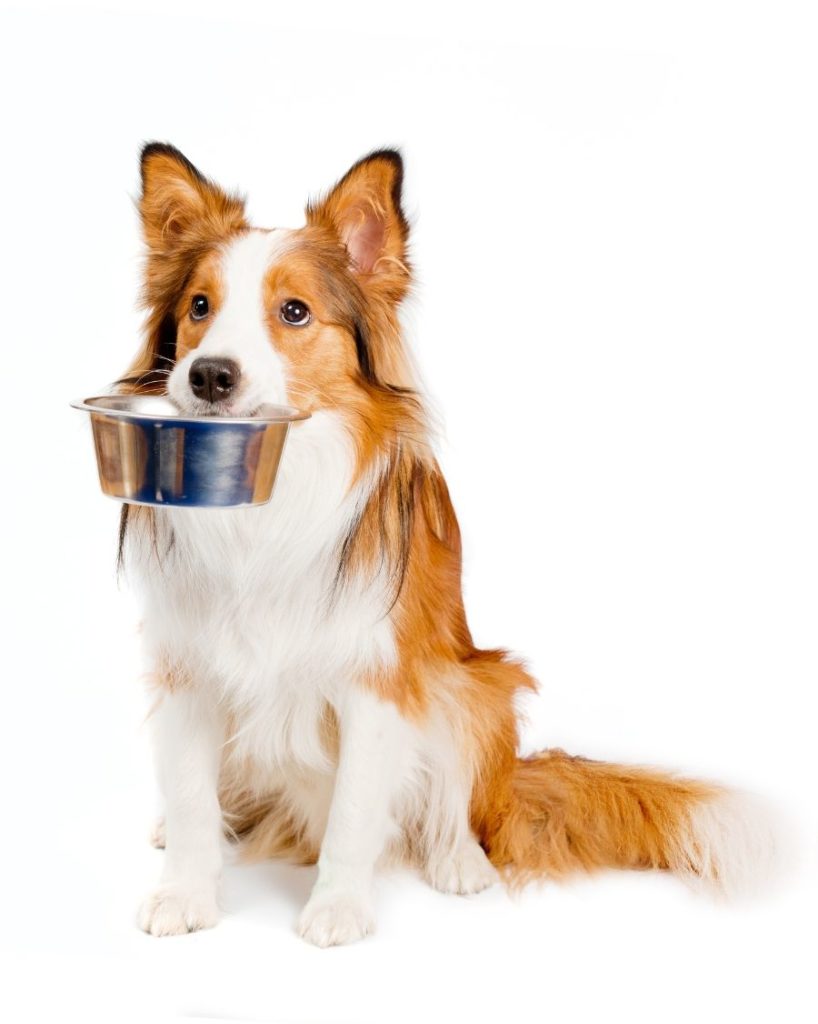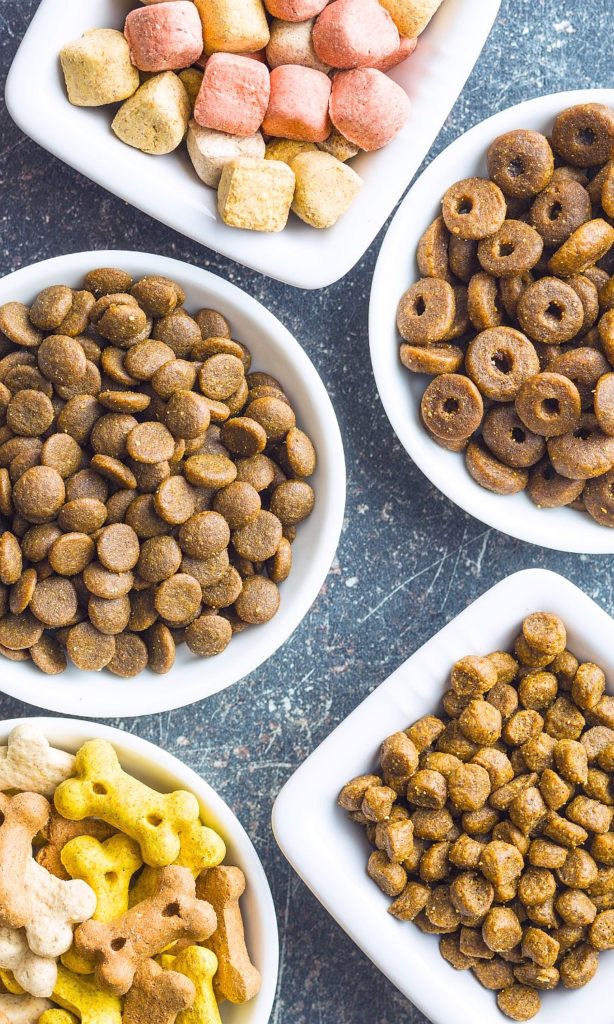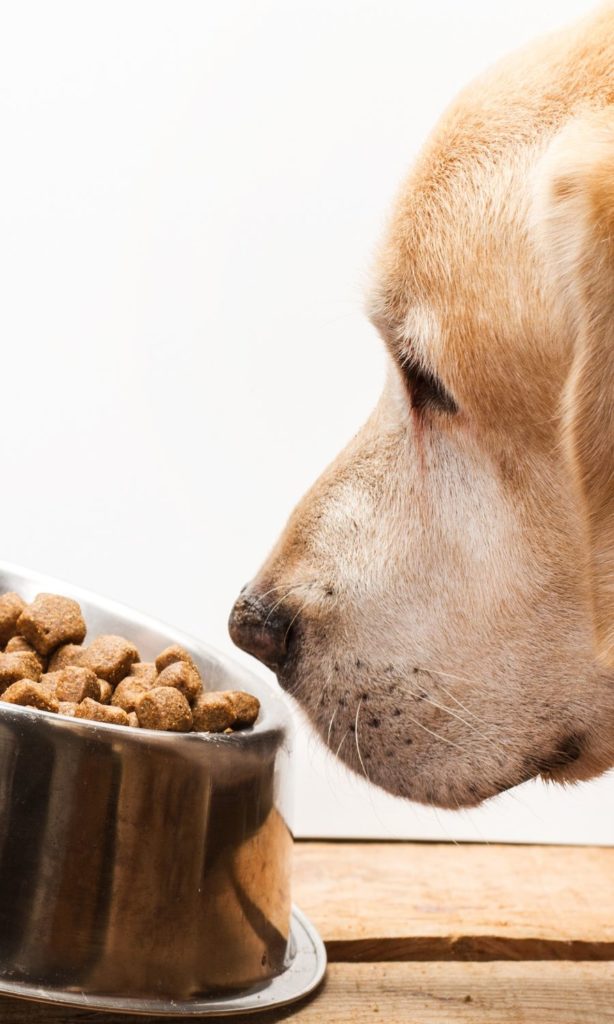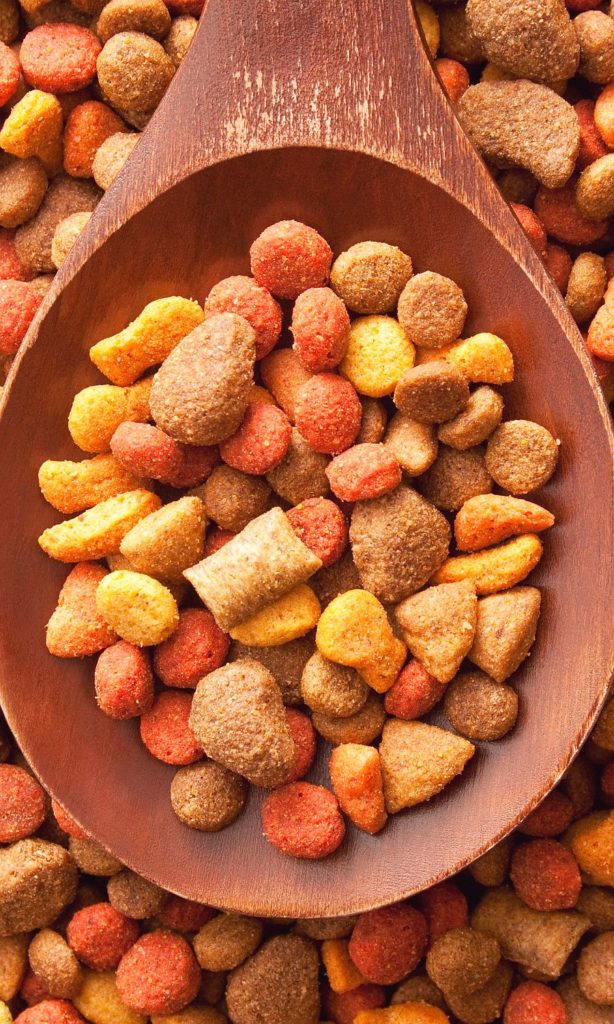Want to know more about artificial and natural flavors in dog food? Let`s talk about how flavored dog food adds aroma to kibble and is used to make a boring meal more enjoyable.
Dog food flavorings are a necessary evil in many commercial diets. They make dogs actually eat and like their food. In this article, we explore everything about added flavors in dog food.
Contents
How Do Dogs Taste Food?
What do dogs actually like?
To understand why dogs prefer some foods over others, we have to dig a little deeper into how they experience their meals.
As you all know, dogs have an incredible sense of smell.

Dogs have hundreds of millions of olfactory receptors in their nose and nasal cavity. These receptors collect scent molecules and send signals to the brain’s olfactory bulb to identify flavor nuances.
Dogs also rely on their sense of smell to figure out how nutritious or safe a food is. For example, they like strong meat aromas, even carrion, but they avoid anything that smells too rancid.
The sense of smell can be thought of as a kind of “chemical scan“. Smell predicts taste and helps select nutritious ingredients.
Dogs like food high in protein and fat and prefer food that smells like it contains many of these nutrients. Serving them low-odor starchy kibble can dampen their desire to eat.
The scent of their food plays a vital role in how dogs perceive its taste. But they have fewer taste buds compared to us and probably can’t distinguish between subtle flavors as well.
Dogs have specific taste receptors that are fine-tuned to meats, fats, and meat-related chemicals due to their ancestral diet being primarily comprised of meat.
PetMD: Do Dogs Have Taste Buds?
Dogs can identify sour, sweet, salty, umami, and bitter.
More specifically…
The main taste buds of dogs are responsive to amino acids, sugars, and substances found in raw meat[2].
Other types of taste buds in dogs are sensitive to organic acids, umami notes, or fruity flavors.
And dogs have taste buds sensitive to water.
This “sensory bias” causes dogs to have an innate preference for certain foods over others.
Most dogs prefer wet, semi-moist, fresh, or raw foods over kibble. This is in line with adult dogs having a preference for food rich in protein and fats and low in carbs[3].
Another legacy of their wolf ancestry is that most dogs are not picky eaters. And most don’t stop eating once they’ve started.
But if the food tastes a lot more boring than it smelled they might not accept it a second time. So food has to smell and taste good.
And if your dog digs in and seems to enjoy every meal eagerly, we’ll assume the food is nutritious, tasty, and a good choice.

Food preferences can be modified by experience or personality.
After eating the same boring food every day, some dogs crave something new from time to time. Others tend to be downright “neophobic” and initially reject any new food[2].
And “emotional” food preference is not limited to dogs.
In fact, the smell of food is an important marketing tool used by companies to build brand identity and brand loyalty. A pleasant aroma can make a product stand out from competitors[11].
Therefore, dog food companies invest significant time and resources into developing the perfect odor for their products, as it can have a direct impact on their sales and reputation.
What is Palatability?
Palatability refers to how appealing and tasty the food is to dogs.
It includes factors like smell, taste, texture, or mouthfeel.
Palatability is an important factor in determining whether or not a dog will touch a particular food.
Dog food manufacturers typically use a variety of techniques to enhance the palatability of their recipes[4].

Because you wouldn’t buy the same product again if it didn’t make your dog happy, would you?
Dog food has to appeal to both you and your dog.
You can certainly think of smells your dog finds much more irresistible than you do, right? But nobody would buy “dead mouse-flavored” food…
So you buy food that you think your dog might like. But it’s always the dog that has the final say on whether he actually does[5].
Dogs prefer beef, pork and lamb to chicken, liver and horsemeat and strongly prefer meat to cereal diets. They prefer canned meat to fresh meat, ground meat to cubed meat and cooked meat to raw meat. Canned or semimoist preparations are preferred to dry ones.
Houpt & Smith 1981[13]
We all want our dogs to enjoy mealtime.
But just like many of us think raw kale tastes just bleh, our dog won’t eat even the most nutritious, complete, or wholesome diet… if it’s unpalatable to him.
To improve palatability manufacturers can include high-quality tasty ingredients or use specific textures and shapes that appeal to a dog’s natural instincts.

But the most savory real ingredients like fats and meat are expensive. And due to production alone, most extruded dry food is highly starchy.
Kibble is enormously popular but tastes rather bland and is the least palatable of all types of dog food[6].
So very many manufacturers choose to use palatants such as artificial flavors and flavor enhancers to simply trick a dog into eating their products.
It’s basically the same as in our snacks, just think of cereal or potato chips…. People most certainly wouldn’t love and overeat them as much if they sold these snacks without flavorings!
Palatants are ingredient systems that are specially designed to improve food consumption. They are designed to appeal to one or more of a pet’s sensory capacities – olfactory, chemaesthetic, taste, and texture.
AFB International on Palatants
What is Added Flavor?
The main purpose of flavored dog food is to draw the dog to the bowl, increase their appetite for the food and make up for the gustatory shortcomings, for example in carb-based pellets.
Flavorings are ingredients or food additives. In general, they can be anything that makes a food more acceptable to your dog.
- Flavoring agents add some new flavor
- Flavor enhancers boost a flavor already present
- Natural flavors are derived from natural sources
- Artificial flavors are not derived from natural sources
There are likely thousands of ingredients manufacturers can use to flavor dog food. These ingredients can not only give more flavor to food, but they can also mask unpleasant off-notes.
And they help to keep the smell of dog food consistent, even if the ingredient quality might differ from batch to batch.
Their main purpose is to add taste and not nutrients.
There are, of course, very many “real ingredients” that also add flavor. Think of salts like monosodium glutamate, sugar, or broth.

Dog foods have very complex aroma profiles[8]. And different types of dog foods call for different flavorings.
Obviously, high-carb kibble smells different compared to canned food. And grain-free products or other limited-ingredient diets tend to be less aromatic than grain-inclusive diets[7].
Additionally, palatants have to serve many different factors such as marketing claims or customer demands.
Manufacturers of natural dog food are more likely to use natural flavors. And many people like aromas they know from human food like steak flavor or bacon flavor[6].
Some products go overboard with flavors and tailor the scent more to the owner’s needs than to the dog’s preferences. For example, mint-flavored snacks are marketed as dental chews, only because we associate mint with toothpaste and good oral hygiene.
In dry foods, the added flavor is often applied as a surface coating. In canned food, palatants get mixed with the food or they are added on top of the food just before the cans get sealed.
Natural Flavors in Dog Food
Dog food ingredients can be confusing, especially when it comes to the natural flavor found in many commercial dog foods.
Well, Their source material might come from nature, but in reality, they are “a far cry from what consumers might expect“[10].
Natural flavors are not always wholesome ingredients.
They are often just chemical compounds that just happen to be obtained as they occur in nature from plant or animal products. They are often made from highly pre-processed ingredients.
For example, “natural bacon flavor” is just a compound that has similar flavor characteristics as fried bacon.
But they can’t be artificially synthesized. The AAFCO definition states that synthetic compounds are not natural ingredients.

According to the FDA, natural flavors include things like extracts, organic acids, essential oils, protein hydrolysates, distillates, or any product of roasting, heating, or enzymolysis[9].
Natural palatants can be made from things like meat, fats, seafood, dairy, eggs, plants, spices, broths, or yeast. But they can also include complex mixtures of isolated chemical substances.
Luckily, since dogs like the smell of meat and fat, most natural flavors are just that. A very common natural flavor is animal digests or hydrolyzed proteins to add or enhance meaty flavors.
These animal-based ingredients are broken down with enzymes or heat into amino acids and fatty acids dogs can smell.
Artificial Flavors in Dog Food
Any flavor additive that doesn’t meet the standards set for natural palatants is categorized as an artificial flavor.
Artificial flavors in dog food are additives that imitate natural flavors without the use of the actual ingredient itself.
These are developed to replicate the flavors and aromas of natural ingredients, such as meats, vegetables, and fruits.
In fact, many of these flavors are derived from natural sources and then further processed to create a synthetic version.
In some cases, if the natural flavors advertised do not actually come from the very product whose flavor is being simulated, a dog food may also be labeled as artificially flavored.
Overall, while artificial flavors may sound like a “fake” or unhealthy addition to dog food, they are actually quite common.
It’s still a relief to know that dog food very rarely actually includes artificial flavorings, isn’t it? The only exceptions seem to be some types of smoke and bacon flavors.
Often labels will bear a claim of “no artificial flavors.” Actually, artificial flavors are rarely used in pet foods.
The major exception to that would be artificial smoke or bacon flavors, which are added to some treats.
FDA on content claims in product names
Are Flavors in Dog Food Ok?
The answer to whether added flavors in dog food are okay for dogs is not a straightforward one.
While most flavors are considered safe and widely used, some consider them controversial or at least questionable ingredients.
While official agencies give assurances on the safety of added flavors, data to back up these claims is limited.
One issue with natural flavors in dog food is that in most cases, the source of those flavors is not specified.
Just “natural flavor,” tells you almost nothing about this ingredient. While it sounds wholesome at first glance, it’s impossible to know precisely what this ingredient is.
And natural flavors could be from chicken or pork, which can be problematic if your pet has a known food allergy.

The main purpose of adding flavors to pet food is to make it more palatable to the dog. And that’s in itself often a sign of an ultra-processed product your dogs would not eat if not fooled into it.
Keep in mind that your dog’s ecstatic response to food is not always an indication of whether a food is healthy or the best choice for him.
Dogs don’t always know what’s good for them.
You’ve likely been there… healthy foods can taste boring, while flavored low-quality junk food can taste fantastic.
Lastly, products aimed at price-sensitive consumers are most likely to save on expensive ingredients that could provide real flavor. So added flavor can be a sign of low-quality ingredients.
Likewise, dog treats are usually made from very cheap ingredients, which is why they have to be packed with flavors.
In conclusion, added flavors are a necessary evil, especially in dry foods, to make dogs eat stuff they might not touch otherwise.
Labeling of Dog Food Flavors
Flavors are food additives but there is no real naming convention.
Most flavors are simply listed as artificial or natural flavor in the statement of ingredients. Sometimes, the flavor is specified a bit more, for example, beef flavor or ham & egg flavor.
But natural flavors also very often get ingredient names such as “hydrolyzed protein“, “liver hydrolysate” or “animal digest“, even though their purpose is not that of a real ingredient.
Also: Pet food manufacturers may use natural flavor blends in their products that are proprietary and don’t always have to disclose exactly how their flavor is made or what it’s made from.
Did you know…
…that the use of flavorings allows manufacturers to incorporate a certain ingredient into the product name without actually using the real ingredient in the food. For example, a “chicken flavored dog food” may only contain some “chicken digest”.
But chicken flavor only creates an aroma that is “representative of chicken“. It can be made from chicken, but it is no longer real chicken. Or at least not what you and I mean by chicken.
So, check the ingredient list before buying flavored dog food.
Whole Grain Corn, Meat And Bone Meal, Corn Gluten Meal, Beef Fat Preserved With Mixed Tocopherols, Soybean Meal, Chicken By-Product Meal, Egg And Chicken Flavor, Whole Grain Wheat, Natural Flavor, Salt, Potassium Chloride, Calcium Carbonate, L-Lysine Monohydrochloride, Choline Chloride, Mono And Dicalcium Phosphate, Minerals, Vitamins, Yellow 6, L-Tryptophan, Yellow 5, Red 40, Blue 2, Garlic Oil
Real Example of a “Chicken Flavor” Dog Food
We all tend to prefer ingredients that we know and understand. But despite the obvious lack of transparency, pet businesses still consider “natural flavor” to be a label-friendly name.
But if you want to know exactly what your dog is eating or your dog has allergies better choose food with named ingredients only.
Further Reading
[1] Regulation (EC) No 1831/2003 […] on additives for use in animal nutrition. https://eur-lex.europa.eu/legal-content/EN/TXT/?uri=CELEX:32003R1831
[2] Bradshaw. The Evolutionary Basis for the Feeding Behavior of Domestic Dogs (Canis familiaris) and Cats (Felis catus). The Journal of Nutrition. 2006. https://doi.org/10.1093/jn/136.7.1927S
[3] Hewson-Hughes et al. Geometric analysis of macronutrient selection in breeds of the domestic dog, Canis lupus familiaris. Behavioral Ecology. 2013. https://doi.org/10.1093/beheco/ars168
[4] Alphia: Palatability And Pet Food: What Is It Really And Why Does It Matter?
[5] Koppel. Consumer sensory cues in pet food selection. Journal of Animal Science. 2020. https://doi.org/10.1093/jas/skaa278.121
[6] Shilpa et al. Dry Pet Food Flavor Enhancers and Their Impact on Palatability: A Review. Foods. 2021. http://dx.doi.org/10.3390/foods10112599
[7] Koppel et al. Volatile Compounds in Dry Dog Foods and Their Influence on Sensory Aromatic Profile. Molecules. 2013. https://doi.org/10.3390/molecules18032646
[8] Maoshen Chen et al. Optimization of key aroma compounds for dog food attractant. Animal Feed Science and Technology. 017. https://doi.org/10.1016/j.anifeedsci.2016.12.005
[9] CFR § 501.22 on labeling of flavorings in animal food
[10] Goodman. The “Natural” vs. “Natural Flavors” Conflict in Food Labeling: A Regulatory Viewpoint. Food Drug Law J. 2017.
[11] Delime et al. How the odor of pet food influences pet owners’ emotions: A cross cultural study. Food Quality and Preference. 2019. http://dx.doi.org/10.1016/j.foodqual.2019.103772
[12] Dinh et al. Fatty Acid Composition of Meat Animals as Flavor Precursors. Meat and Muscle Biology 2021. https://doi.org/10.22175/mmb.12251
[13] Houpt & Smith. Taste preferences and their relation to obesity in dogs and cats. Can Vet J. 1981. PMID: 7248879
